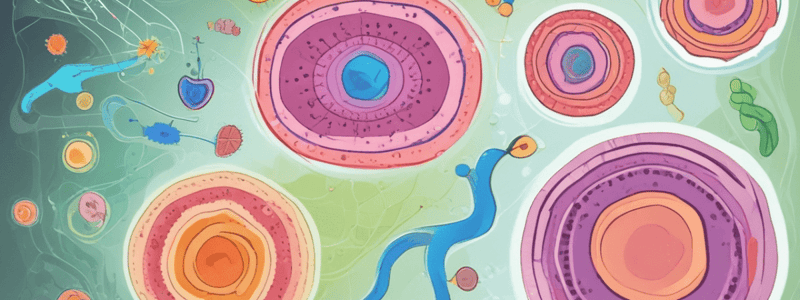Podcast
Questions and Answers
What is the fluid content inside the plasma membrane and excluding nucleus called?
What is the fluid content inside the plasma membrane and excluding nucleus called?
- Cytosol
- Endoplasmic Reticulum
- Cell Wall
- Cytoplasm (correct)
What is the characteristic of prokaryotic bacteria chlorophyll?
What is the characteristic of prokaryotic bacteria chlorophyll?
- Associated with membranous vesicles (correct)
- Associated with cell wall
- Associated with plastids
- Associated with nucleus
What is the primary function of ribosomes?
What is the primary function of ribosomes?
- Protein construction (correct)
- Cell division
- Cell signaling
- Protein breakdown
Why don't viruses show characteristics of life until they enter a living organism?
Why don't viruses show characteristics of life until they enter a living organism?
What is the irregularly shaped region within the cell of a prokaryote that contains genetic material?
What is the irregularly shaped region within the cell of a prokaryote that contains genetic material?
What is the term for the region between the cell membrane and the nucleus?
What is the term for the region between the cell membrane and the nucleus?
What is the outermost layer of the cell that separates the cell from its environment?
What is the outermost layer of the cell that separates the cell from its environment?
What is the process by which water molecules move from a higher concentration to a lower concentration through a partially permeable membrane?
What is the process by which water molecules move from a higher concentration to a lower concentration through a partially permeable membrane?
Who is credited with the discovery of cells?
Who is credited with the discovery of cells?
What is the function of the nucleus in a cell?
What is the function of the nucleus in a cell?
What is the function of the rough endoplasmic reticulum?
What is the function of the rough endoplasmic reticulum?
What is the function of the cell wall in plant cells?
What is the function of the cell wall in plant cells?
What is the function of lysosomes in a cell?
What is the function of lysosomes in a cell?
What is the primary function of the Rough Endoplasmic Reticulum?
What is the primary function of the Rough Endoplasmic Reticulum?
What is the main function of Mitosis in cell division?
What is the main function of Mitosis in cell division?
Which organelle is responsible for storing genetic information in a cell?
Which organelle is responsible for storing genetic information in a cell?
What is the characteristic of vacuoles in plant cells?
What is the characteristic of vacuoles in plant cells?
Where are ribosomes typically found in a cell?
Where are ribosomes typically found in a cell?
Study Notes
- In prokaryotic cells, chlorophyll is associated with membranous vesicles, not with plastids like in eukaryotic cells.
- The nucleoid is an irregularly shaped region within a prokaryote cell that contains most of the genetic material.
- Cytoplasm is the fluid content inside the plasma membrane, excluding the nucleus, and consists of cytosol and various cell organelles.
- Cell organelles are sub-cellular structures with characteristic form, structure, and function, and are almost all surrounded by a membrane.
- Viruses lack a membrane and do not show characteristics of life until they enter a living organism and use its cell machinery to multiply.
- Ribosomes are the smallest and membrane-less cell organelles, composed of RNA and proteins, and are responsible for protein synthesis.
- Centrioles are present in all animal cells but only in lower plant forms.
- Golgi apparatus, also known as dictyosomes, is present in both plant and animal cells.
- Mitochondria are present in both plant and animal cells and are responsible for generating energy for the cell.
- Vacuoles are small in animal cells but can occupy up to 90% of cell volume in plant cells.
- Lysosomes are responsible for breaking down cellular components and can cause cell destruction if they burst.
- Mitosis is the process of cell division that results in two identical daughter cells with the same number of chromosomes as the mother cell, and is essential for growth and repair of tissues in organisms.
Studying That Suits You
Use AI to generate personalized quizzes and flashcards to suit your learning preferences.
Description
Test your knowledge of cell structure and organelles, including prokaryotic and eukaryotic cells, chlorophyll, and membranous vesicles. This quiz covers the basics of Class 9 Biology.




